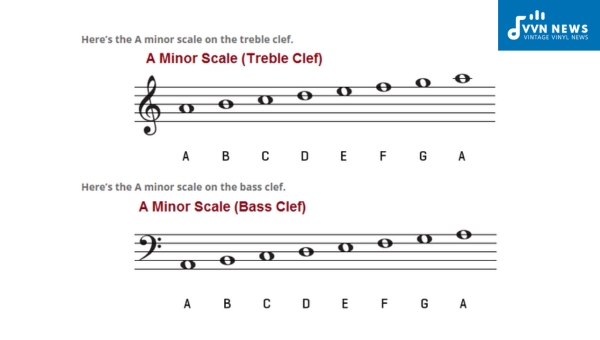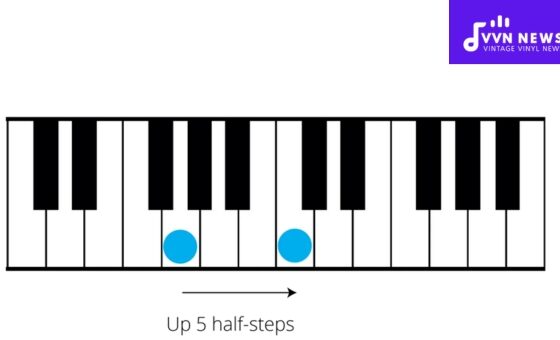Music has a captivating way of expressing itself, and the minor scales play a vital role in its articulation.
Among all, one that stands out from the crowd due to its vibrant, soulful quality is the A minor scale.
It’s a fascinating realm of sounds waiting to be explored and admired for its richness and versatility.
This is where I step in to shed some light on what makes this minor scale so enchanting.
Let’s embark on an exciting journey of learning the essence of the A Minor scale, unlocking its secrets, and discovering how it can redefine your musical expertise.
With this guide, you can harness the transformative power of this memorable melodic instrument to evoke profound emotional responses in your listeners or create enchanting melodies for your pleasure.
What is the process for forming the A Minor Scale?
The process of creating the A Minor scale, like other musical scales, is based on a series of half and whole steps.
Whole steps refer to two frets or keys apart, while half steps are one fret or key apart.
For the A Minor scale, we follow a particular pattern that gives this scale its unique and captivating sound: whole step, half step, whole step, whole step, half step, whole step, and a final whole step. Essentially:
- Step 1: Begin at the note ‘A’.
- Step 2: Move up a full (whole) step to ‘B’.
- Step 3: Now move up a half-step to ‘C’, followed by a full step to ‘D’.
- Step 4: Continue with another full step to reach ‘E’, then yet another half-step moves you to ‘F’.
- Step 5: Your next move is a full step leading you to ‘G’, followed by your final full step taking you back beautifully around to the original note – concluding your journey right where you started – on an ‘A.’
It’s truly thrilling how these series of steps build up that characteristic melancholy sound of the A Minor scale, which differentiates it from other scales in music.
What are the specific degrees of the A Minor Scale?
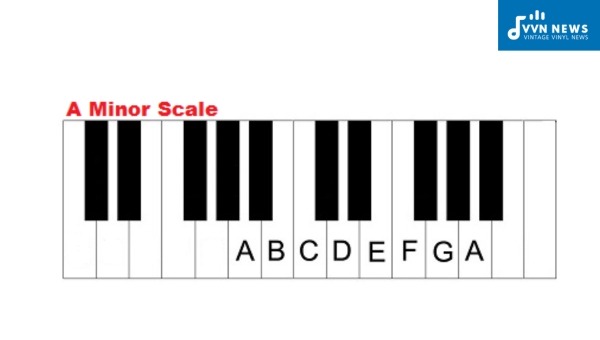
The musical degrees of the A Minor scale provide a deep insight into its composition, structure, and resolving tendencies.
The specific degrees of the A Minor scale are as follows:
- 1st Degree (Tonic): The first note is the root of the scale, and this is A within our context.
- 2nd Degree (Supertonic): The second degree in this framework is B – it falls right after our tonic.
- 3rd Degree (Mediant): Next up, we have C for a deeper emotional resonance. This attribute makes it widely appreciated in ballads and soulful tunes.
- 4th Degree (Subdominant): Heading forth on this melodic pathway is D – considered vital to create tensions within music compositions.
- 5th Degree (Dominant): Followed by D, we find E plays an important role known as the dominant.
- 6th Degree (Submediant): Now coming to F, a unique note that adds intrigue to any musical piece.
- 7th Degree (Leading Tone/Sub-tonic): To wrap it all up, G stands as our seventh degree, offering variety and paving the way for progression back to the tonic note.
The ways these degrees interact and flow within a composition craft unique melodies.
With musical degrees, you will paint your songs with rich emotional hues, allowing you to channel creativity within the realm of melody construction.
Also Read: Guide Of Piano Chords [Unlock Your Musical Potential Today]
How do you play the A Minor Scale on both piano and guitar?
Learning to play the A Minor scale implies stepping into a world of profound emotion and artistic expression.
You’ll be relieved to know that it’s not a challenge that tests your limits; rather, it’s an enjoyable journey.
Today, we will explore two popular instruments – piano and guitar, showcasing the steps necessary to bring out the melodic grace of this scale.
Playing the A Minor Scale on the Piano
To play the A Minor scale on piano, follow these crucial steps:
- Extend your fingers over the piano keys, ensuring that your thumb is resting on middle C.
- Start with your right thumb (fingering 1) on A.
- Follow this sequence for playing the notes: A with the thumb (1), B with the index finger (2), and C with the middle finger (3).
- Cross your thumb beneath your hand to play D (1), followed by E with the index finger(2), F with the middle finger (3), G using the fourth finger(4), and complete the scale by playing A using the pinky or fifth finger (5).
For left-hand fingering, begin at high-A using your pinky and descend the keyboard:
- Play high-A with pinky (5), G with ring finger(4), F with middle finger(3), and E using second or index finger(2).
- Allow your thumb to glide underneath your hand to hit D, then continue descending by playing C at 2nd or index finger, B using the third or middle finger, and returning to A using the fourth or ring finger.
Make sure that all notes should be played smoothly and sequentially without any hurry.
Playing the A Minor Scale on Guitar
If you are more accustomed to strings rather than keys, fret not! I have got you covered as well.
To perform an open position A minor scale on guitar:
- Begin by playing open A string.
- On the fifth string, play the second fret using the first/middle/index finger and then the third fret utilizing the third/ring finger.
- Proceed to the fourth string – play open D followed by the second fret, making use of the first/middle/index finger.
- When arriving at the third string, play open G smoothly after the fourth String’s second note.
- To complete your scale, play the first fret of the second string using the first/index finger.
As you grasp the scale, try to connect notes without hesitating to create a musical flow.
In both instruments, consistency is key, and perfect synchronization between your two hands would indeed lead to harmonious music in minor scales.
How is the A Minor Scale represented in different clefs?
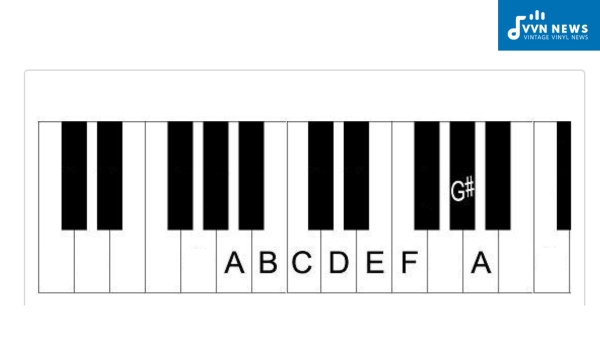
The A Minor scale can be represented in three different musical clefs – treble, bass, and alto.
Each of these clefs presents the A Minor scale differently according to their unique pitch ranges.
It’s a fascinating process to witness how the same scale transfigures when written in distinct clefs.
Treble Clef
When written in the treble clef, which is typically used for higher pitched instruments such as violin or flute (and is also frequently seen for piano music), the A minor scale starts on the white key just below Middle C.
It uses only those keys that are white all up to the higher A. This particular pattern has no sharps or flats, making it easy to decipher for beginners.
Under this clef, traveling along the A Minor Scale feels like embarking on a journey with eight distinct steps, A-B-C-D-E-F-G-A, but each breathtaking in its singularity.
Also Read: How To Transpose Bass Clef To Treble Clef [A How-To Guide]
Bass Clef
The bass clef offers a vantage point vastly different from that of the treble.
Its lower register makes it ideal for bass voice and lower-pitched instruments like the cello or double bass.
In a bass clef notation, A Minor Scale unfolds from an A note two and a half ledger lines above the main five lines of our staff paper — just between F and G on your piano keyboard. Again, there aren’t any sharps or flats involved — another reason to prefer this minor scale while learning music.
You’ll appreciate how gracefully A-B-C-D-E-F-A-G notes transition from one to another under this bass perspective without requiring unusual bends at tricky half steps.
Alto Clef
Lastly comes our Alto Clef – often reserved for less commonly played instruments like viola or some high-pitched brass.
In an alto clef representation of our favorite A Minor Scale, ‘A’ would fall on the first space (from bottom to top) of the five lines on our staff paper, also known as third line C.
Our A minor scale rhythmically strolls through ABCDEFAG notes, packing no less allure than its other counterparts.
The representation of the A Minor Scale in different clefs can certainly open new doors of perception and experiment for you, reshaping how you approach and admire the beauty of music.
What is the Key Signature for A Minor Scale?
The A minor scale boasts of a key signature with no sharps or flats. In music theory, a key signature communicates the tonality of the music by indicating what pitches to sharpen or flatten consistently within the piece.
A minor is unique in its simplicity. This simplicity also renders it as an excellent scale for beginners to learn and play with ease.
Here’s where it becomes revelatory: While A minor shares its lack of sharps and flats with its relative major counterpart, C Major, the two scales exhibit wonderfully distinct moods due to their different tonal structures.
Relative Major Key to A Minor Scale
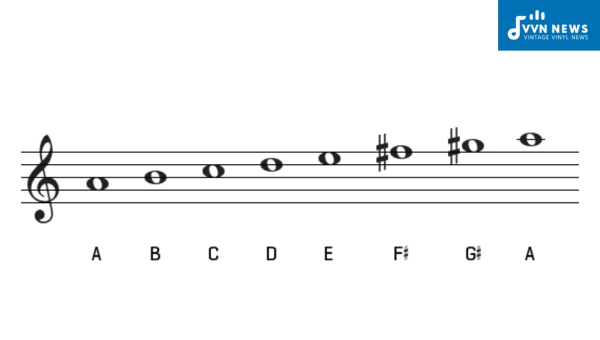
Every minor key has a relative major, distinguished by the sharing of the same key signature.
The relative major of the A Minor scale is C Major. This means that these two scales – A Minor and C Major – have the same notes but start from different places.
They are intertwined in their essence, providing opportunities for seamless transitions and rich musical experimentation.
The beauty lies within its simplicity: no sharps or flats to worry about, making it a perfect starting point for novices in reading music sheets or composing melodies.
Identifying Chords within the A Minor Scale
To grasp the essence of the A Minor scale, you should become familiar with its chords.
The beauty of this minor scale lies in forming its rich tones into chords. And trust me, it’s not as complex as it may sound at first.
Let’s break down the seven primary chords in the A Minor scale:
- A Minor (Am): A – C – E
- B diminished (Bdim): B – D – F
- C Major (C): C – E – G
- D Minor (Dm): D – F – A
- E Minor (Em): E – G – B
- F Major (F): F – A – C
- G Major (G): G – B – D
This list sequences all chords from their root note (A) to other notes using keys from A to G.
By playing these specifics one by one, you will get a true feel of the A minor scale’s musical prowess.
Also Read: B Minor Scale Explained [Play More Expressively On Your Guitar]
FAQs About The A Minor Scale
What makes the A Minor scale unique?
The A Minor scale stands out for its melancholy sound. Its distinct tonality invokes a sense of somberness or introspection, distinguishing it from more jovial major scales.
Can I improvise with the A Minor Scale?
Absolutely! The A Minor scale is perfect for improvising, especially in genres like blues, jazz, and rock. It gives you a vast range of notes to experiment with.
How does the A minor scale look on sheet music?
In music notation, the A minor scale is written using natural symbols before every note. It’s one of the easiest scales to read.
Is the A minor scale suitable for beginners?
Yes! The A minor scale is often recommended for beginners because it’s easy to learn and play on most instruments.
How does playing in the A minor affect a song’s emotion?
When you play a song in the A minor key, it typically sounds more sentimental and emotional compared to songs played in major keys.
Conclusion
The world of music is as vast as it is beautiful, and the A Minor Scale is but one enchanting piece of this boundless landscape.
On your journey through the harmonious realm of music, you’ve stumbled upon a path that has enriched countless melodies with its sorrowful and touching tones.
As an ever-learning musician, you should continue to explore and master this exquisite minor scale. Its evocative power is key to unveiling even greater depths of your musical potential.
Surely, no musical exploration would be complete without gaining an intimate familiarity with the allure of the A Minor Scale.
